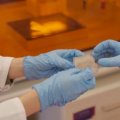The University of Queensland is attracting more than $130 million in research income annually and receives more industry support for its projects than any other Australian university.
The breadth of the University’s world-class research portfolio will be showcased during the inaugural UQ Research Week from September 23-27.
Vice-Chancellor Professor John Hay said the University’s research and research-training performance consistently ranked between first and third among Australian universities on most readily available measures.
He said the University’s research initiatives and achievements were playing a pre-eminent role in establishing Queensland as the “Smart State”.
“Research Week will highlight some important projects and, through the UQ Foundation Research Excellence Awards, introduce the work of some of our brightest young researchers,” Professor Hay said.
The University:
– placed first among Australia’s 39 universities for industry and related research income and second for total reported research income in 2001;
– attracted more than $131 million total research income in 2001 – a 13 percent increase on the 2000 performance; and
– had sourced more than $49 million in research income from industry in 2001, underscoring UQ’s ability to attract funding from less traditional sources. This represented a 21 percent increase on the 2000 figure, which was in itself higher than any other Australian university for that year.
The University’s 17 areas of research strength include:
– materials and nanotechnology; biotechnology; complex and intelligent systems; quantum and photon science and technology; marine science; neuroscience; critical, cultural and media studies; institutional and organisational change; and imaging science and technology
World-class infrastructure underpinning the University’s areas of research strength include:
– the $105 million Institute for Molecular Bioscience (IMB); the Australian Genome Research Facility; three marine research stations; state-of-the art high-performance computing facilities including advanced visualisation and virtual reality capability; an internationally recognised library (or cybrary); the most extensive NMR facility in Australia; a University mine and major minerals processing facility; and three University farms and three veterinary clinics spread throughout Queensland.
The University also offers graduate programs in all disciplines. In 2001, there were 3398 higher degree research students and of these, 14 percent were international students.
Also, in 2001, the University had the largest number of PhD students of any university in Australia. In that same year, the University graduated 313 PhD candidates, more than all but two other Australian universities.
According to the Graduate Destinations Survey (GDS), almost 88 percent of the University’s research higher degree students submitting theses by December 2000 had employment by April 2001.
The UQ Research Week program is online at www.uq.edu.au/research/index.html?id=5512
Media: For more information, contact Brad Turner at UQ Communications (telephone 07 3365 2659 or email: communications@uq.edu.au).
.jpg)



